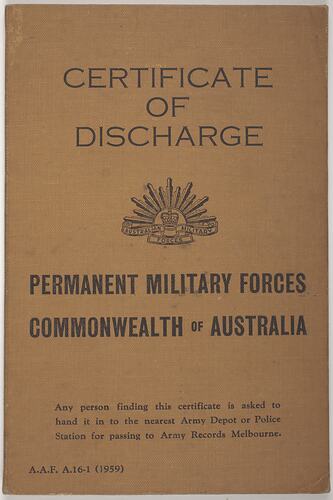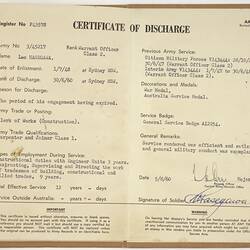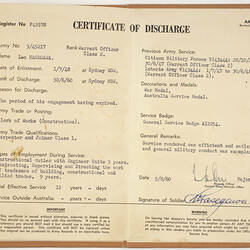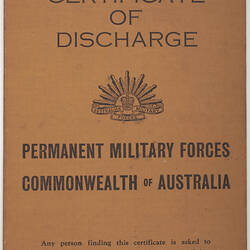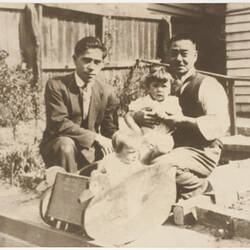Summary
Certificate of Discharge issued to Leo (Leonard Takeshi) Hasegawa upon the completion of his service in 1960. It records his early citizen and interim army service, from 1941-1948, his date of enlistment 1 July 1948, his posting as Clerk of Works (Construction) from 1948-1960, his qualifications, carpenter and joiner, and his date of discharge 30 June 1960 in Sydney.
Leo was born in 1906 in Geelong, the son of Japanese migrant Setsutaro Hasegawa, who arrived in Australia in 1897, and Australian-born Ada Cole. Leo married Edna Ida Gladys Jorgensen in 1929. Leo successfully petitioned for his father's early release from Tatura in 1943, after he was interned as an enemy alien in 1941, following the outbreak of war with Japan.
Setsutaro migrated to Australia from Japan in 1897 at the age of 26, just four years before the introduction of the Immigration Restriction Act which severely limited migration to Australia from countries in Asia. He established a laundry business in Geelong and by 1911 he had married an Australian-born woman and had three children.
In 1941 Setsutaro was arrested as an enemy alien and sent to Tatura internment camp in northern Victoria. Released early in 1943 due to his age and poor health, unlike most Japanese interns he was not deported to Japan after the War. Setsutaro remained in Geelong for the rest of his life and died in 1952.
Physical Description
Brown hard cover certificate. Inside cover is a sheet attached to right hand side with details regarding Leo Hasegawa and his military record. It outlines his dates of enlistment and discharge, posting, qualifications, previous army service, decoration and medals, employment and character remarks.
Significance
The Hasegawa collection enables the exploration of a number of important historical themes relating to migration, working life, and wartime internment in Victoria. Late nineteenth century and early to mid twentieth century Japanese migration and settlement experiences are little represented in the museum's collections and this collection of clothing, documents, personal items and photographs helps to redress.
More Information
-
Collecting Areas
-
Acquisition Information
Donation from Andrew Hasegawa, Andrew Hasegawa, 08 Feb 2008
-
Issued By
Australian Commonwealth Military Forces, Canberra, Australian Capital Territory, Australia, 1960
-
Issued To
Leo T. Hasegawa, Sydney, Greater Sydney, New South Wales, Australia, 1960
-
Inscriptions
Printed on cover: 'Certificate of Discharge. Permanent Military Forces Commonwealth of Australia.'
-
Classification
-
Category
-
Discipline
-
Type of item
-
Overall Dimensions - Folded
128 mm (Width), 193 mm (Height)
-
References
5 family photographs (need originals from donor to scan)
-
Keywords
Australian Military Forces, Carpentry, Construction Industry, Immigration, Japanese Communities, Japanese Immigration, Joinery Industry, Militaria: Australian, World War II, 1939-1945
